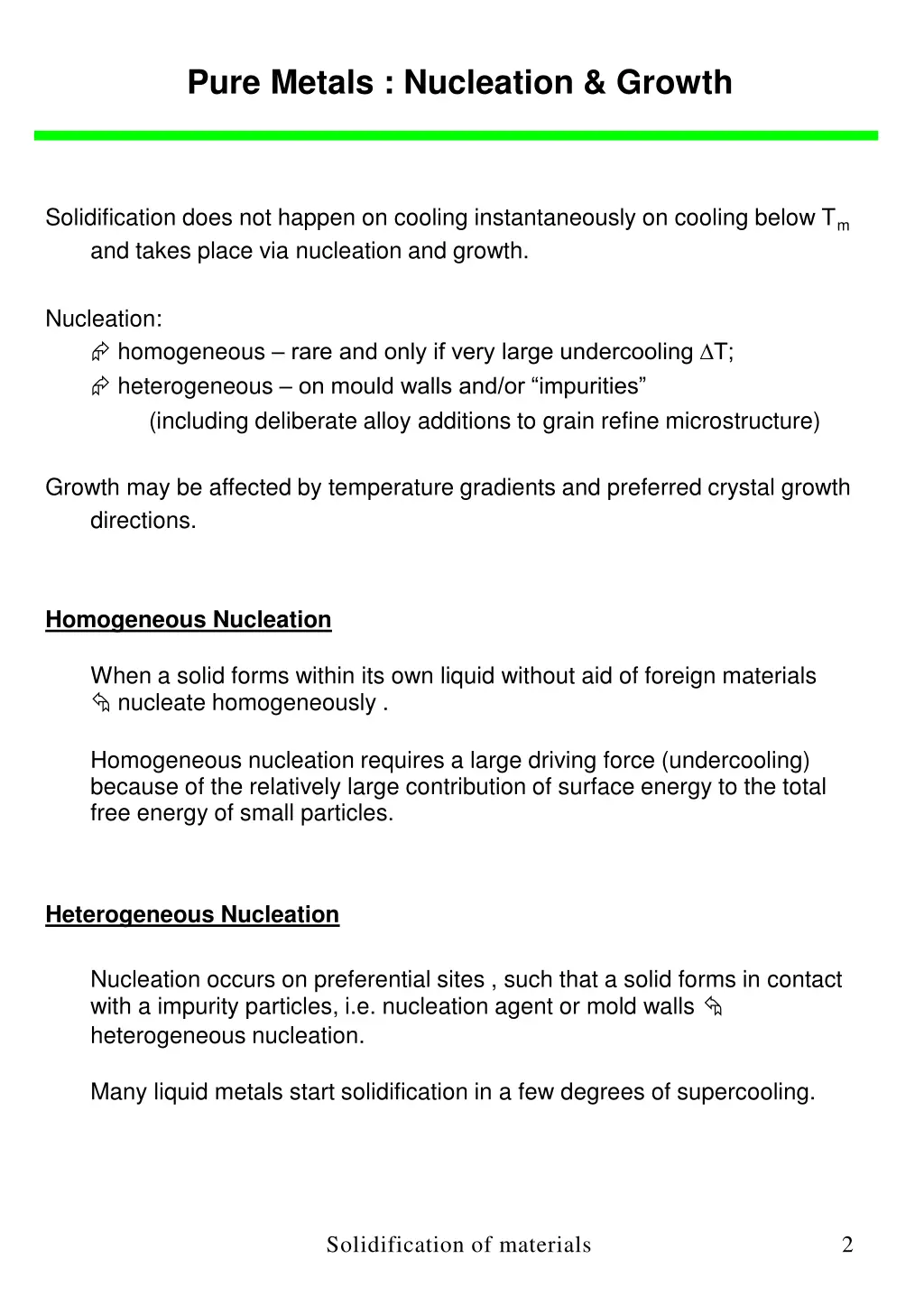
Understanding Nucleation and Growth in Pure Metals: Solidification Process
Discover the intricate process of nucleation and growth in pure metals during solidification, where solid formation is not instantaneous but occurs via nucleation and growth mechanisms. Learn about homogeneous and heterogeneous nucleation, as well as the factors influencing crystal growth direction. Explore the concept of excess free energy and the critical role it plays in the formation of solid particles. See examples of homogeneous nucleation and unravel the phenomena governing the stability and growth of solid particles.
Download Presentation

Please find below an Image/Link to download the presentation.
The content on the website is provided AS IS for your information and personal use only. It may not be sold, licensed, or shared on other websites without obtaining consent from the author. If you encounter any issues during the download, it is possible that the publisher has removed the file from their server.
You are allowed to download the files provided on this website for personal or commercial use, subject to the condition that they are used lawfully. All files are the property of their respective owners.
The content on the website is provided AS IS for your information and personal use only. It may not be sold, licensed, or shared on other websites without obtaining consent from the author.
E N D
Presentation Transcript
Pure Metals : Nucleation & Growth Solidification does not happen on cooling instantaneously on cooling below Tm and takes place via nucleation and growth. Nucleation: homogeneous rare and only if very large undercooling T; heterogeneous on mould walls and/or impurities (including deliberate alloy additions to grain refine microstructure) Growth may be affected by temperature gradients and preferred crystal growth directions. Homogeneous Nucleation When a solid forms within its own liquid without aid of foreign materials nucleate homogeneously . Homogeneous nucleation requires a large driving force (undercooling) because of the relatively large contribution of surface energy to the total free energy of small particles. Heterogeneous Nucleation Nucleation occurs on preferential sites , such that a solid forms in contact with a impurity particles, i.e. nucleation agent or mold walls heterogeneous nucleation. Many liquid metals start solidification in a few degrees of supercooling. Solidification of materials 2
Homogeneous Nucleation (I) F f li id t t T b l Free energy of liquid at a temp. T below Tm G1 G1 = (VS + VL )GV L If some of atoms of liquid cluster together form a small cluster sphere of solid, the free energy of the system will change to G2 S L G2 = VSGV + VLGV + ASL SL VS : volume of solid sphere, G S , G L : free energies per unit volume of solid and liquid respectively V V ASL: solid/liquid interfacial area, SL: solid/liquid interfacial free energy VL : volume of liquid Free energy change due to the formation of solid G = G2 G1 = V (GL GS)+ A S V V SL SL = VS GV +ASL SL Gv is positive below Tm , so that Negative contribution due to the lower free energy of a bulk solid Positive contribution due to the creation of solid/liquid interface Solidification of materials 3
Homogeneous Nucleation (II) G = VS GV + ASL SL The excess free energy associated with the solid particles can be minimized by the formation of sphere of radius r G = 4 r3 G 3 + 4 r2 V SL If a very small solid particle forms, the retarding energy ( Gs) term is larger than the driving energy ( Gv). the creation of small solid particles leads to a free energy increase. liquid phase is able to maintain in a metastable state almost infinitely at temperatures below Tm. Solidification of materials 4
Homogeneous Nucleation (III) G = 4 r3 G 3 + 4 r2 V SL At a given T, If r < r*, a small increase in radius r results in an increase of the total free energy which is not a spontaneous process. the system can lower its free energy by dissolution of solid particle unstable solid particles with r < r*, embryos Only if r > r*, the growth of solid proceeds spontaneously with decrease in free energy of the system. the system can decrease its free energy by growth of solid particle stable solid particles with r > r*, nuclei i ll d i i l di f l i l hi h bl h r* is called as critical radius of "nuclei" (clusters which are able the grow). At the critical radius the total free energy change has a maximum G* which is known as nucleation barrier. Solidification of materials 5
Homogeneous Nucleation (IV) Estimation of the size of the critical radius dG = 0 when r = r* the critical nucleus is in equilibrium with the surrounding liquid di li id Differentiation of the total free energy equation with respect to r, and d G dr = 0 , at r = r* r =r* G = 4 r3 G 3 = 4 r*2 G + 8 r* r =r * + 4 r2 V SL d G dr G = 0 V SL and therefore, 2 SL GV 1 2 SL Tm r = = L T 16 T = 3L2 ( T)2 3 3 2 16 3( G 1 m G = SL SL )2 V The size of r* is reduced by greater undercooling ( T), this means that smaller nuclei are able to grow. Without undercooling, the nucleation will not start (if T = 0, then r* ). The nucleation barrier G* is also inversely related to T: the nucleation barrier decreases as the undercooling increases. Solidification of materials 6
Homogeneous Nucleation (V) For FCC Copper, r* 1 nm, which contains 310 Cu atoms in each nucleus. A solid sphere of r will have a free energy greater than that of bulk solid by 2 r per unit volume. Solidification of materials 7
Homogeneous Nucleation (VI) Formation of solid nucleus Many small close-packed clusters of atoms (crystalline atomic array) present in the liquid Total number of atoms in liquid, n0 The number of spherical clusters of radius r, nr Gr ) kT n = n exp( r 0 Gr: the excess free energy associated with cluster, k : Boltzmann constant For a liquid above Tm , this relationship applied for all values of r, but for a solid, the relationship only applied for r r* Since nr decreases exponentially with Gr(which itself increases rapidly with r), the probability of finding a given cluster decreases very rapidly as the cluster size increases for example) at Tm, Cu (1020 atoms/mm3) contains ~1015 clusters of 0.3 nm (~10 atoms) and ~10 clusters of 0.6 nm (~100 atoms) Maximum size of clusters in the liquid increases with decreasing temperature. Critical nucleus size r* 1/ T For supercollings of DTN or greater, some clusters reaches r*, and growing into stable solid particles Solidification of materials 8
Homogeneous Nucleation (VII) Homogeneous Nucleation Rate The cluster with a critical radius r* will convert stable nucleus by addition of a single atom to a critical nucleus P : frequency with which the addition of a single atom to a critical nucleus makes that nucleus is supercritical and able to grow rapidly Gi) kT 1n 6 exp( P = L 1/6 : possibility with which atom directs to the L/S interface nL : possibility with which each atom jumps across the L/S interface : the number of atoms surrounding a critical nucleus : atomic vibration frequency (~kT / h, h : Plank constant) ( /kT) th d i b i t j i t t iti l l exp (- Gi/kT) : thermodynamic barrier to join atom to critical nucleus - Nucleation Rate, Nhom Gr + Gi) kT 1n N = n P= hom n exp( 0 L r 6 6 Gr ) kT n0kT h exp( 3 2 16 SL Tm 2 3L kT n0kT h A A = exp 2 ( T) At low undercoolings, the nucleation barrier is high and the rate of nucleus formation is low. Greater undercooling promotes the nucleation due to decrease in r* and G*. Solidification of materials 9



![Lec [2] Health promotion](/thumb/274962/lec-2-health-promotion-powerpoint-ppt-presentation.jpg)
